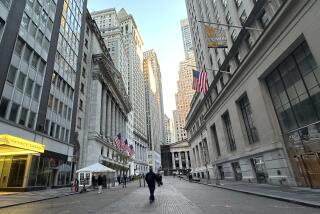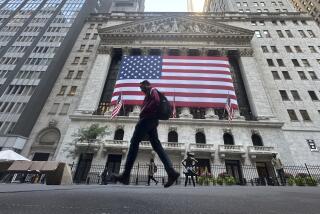Dollar Jumps to Highest Levels in Several Months : Dealers Say Gains Reflect Confidence in Economy, Belief Move Is Sanctioned
- Share via
The dollar surged to its highest levels against foreign currencies in several months Friday, reflecting growing confidence in the U.S. economy and a view that America’s major trading partners sanction the climb, analysts said.
“It would take some kind of a catastrophe at this point in time to send the dollar back down again,” said Charles A. Spence, a vice president in the foreign exchange area at First Interstate Bancorp in Los Angeles.
Although the dollar’s long-term strength remains uncertain, its swift rise prompted central banks in West Germany and France to unload greenbacks in an attempt to cool the rally. In addition, there were rumors that the U.S. Federal Reserve had done likewise.
The dollar closed in New York at 130.45 Japanese yen, up from 128.60 on Thursday. It also gained on the West German mark, trading at 1.8145, up from 1.7850. The dollar has now reached a level relative to the mark not seen since late last year.
The two-week rally, triggered by a flurry of economic developments, has enabled the dollar to recapture some 15% of its value relative to the mark and more than 7% against the yen. The developments included a Commerce Department report earlier this month that the U.S. trade deficit reached a 40-month low in April, the second month in a row of significant improvement. In addition, short-term U.S. interest rates have been rising faster than those in Japan and West Germany, making dollar-denominated investments more attractive to investors.
The newly favorable psychology surrounding the dollar was reinforced earlier this week when the seven major industrial democracies declared in Toronto that a limited rise in the currency was acceptable.
Broke Through Barriers
“You put all that (economic news) together, and you look at the comments coming from the authorities, and all of a sudden the dollar looks well underpinned,” said Brian Cronin, a vice president in the foreign exchange area at Security Pacific Merchant Bank in Los Angeles. He added: “I think we may already have seen the lows for the year.”
Earlier Friday, the dollar failed to surmount the symbolic barriers of 130 yen and 1.80 West German marks in Tokyo trading. It hovered at those levels in Europe and then shattered them in New York, buoyed by a financial news report that U.S. officials would tolerate a markedly higher climb. A Treasury Department spokesman denied the report, but that did little to deflate the move.
“For the near future, we expect the dollar to rise,” said Michael G. Papaioannou, director of the foreign exchange service for the WEFA Group, an economic consulting firm in Bala Cynwyd, Pa., underscoring questions about the currency’s long-term power.
Until recently, U.S. officials have approved the dollar’s fall as a way to shore up the competitiveness of American products because it make them relatively less expensive than those from Japan, Western Europe and some other regions. Recent evidence of an improving U.S. trade situation seems to have vindicated the policy. But in light of the success, analysts believe that the United States will combat any major dollar comeback by unloading greenbacks on currency markets.
Any move to much higher levels “is going to have very negative effects” on U.S. industry and would undermine the recent export gains, warned Stephen L. Cooney, director of international investment and finance at the National Assn. of Manufacturers in Washington.
Expected to Fade
In addition, Japan and other foreign governments--their economies buffeted by the dollar’s long, uneven fall in value--said in Toronto that they supported the goal of stable currencies, underlining their own willingness to intervene if the dollar rises or drops too sharply on the chaotic currency markets.
Papaioannou estimated that the upper levels agreed on by the industrial democracies would be about 133 yen and 1.82 West German marks. “They’re not going to let the dollar increase to higher rates than expected,” he maintained.
Moreover, some analysts believe that the dollar’s current strength is destined to peter out. If foreign interest rates rise in the short term, which some expect, the dollar could lose much of its luster. More fundamentally, economists point to signs that America is losing its traditional surplus in services trade, just at a time when it is narrowing its merchandise trade deficit.
In the first three months of this year, for example, the United States had a $655-million deficit in services, including many financial transactions with foreigners. Analysts said that a potentially troubling trade gap in services--one that could erode the dollar--may emerge because the United States owes foreign investors increasing amounts of interest, dividends and other payments.
“This is fundamentally bad news for the long term,” said Lisa Finstrom, a currency analyst with Shearson Lehman Hutton in New York.
Just as the lower dollar has helped the U.S. economy, a stable or rising dollar has potential benefits as well. “It helps both with inflation and interest rates,” said Carol A. Stone, senior economist with Nomura Securities International in New York. That is because a strong dollar tends to lower the price tags on imports entering the country, and it attracts foreign investment, thus acting as a brake on interest rates.
Stone said the services trade situation is “a definite negative in the outlook for the dollar. Whether it will be the most powerful force, I don’t know.”
Tables, Page 8
More to Read
Inside the business of entertainment
The Wide Shot brings you news, analysis and insights on everything from streaming wars to production — and what it all means for the future.
You may occasionally receive promotional content from the Los Angeles Times.










